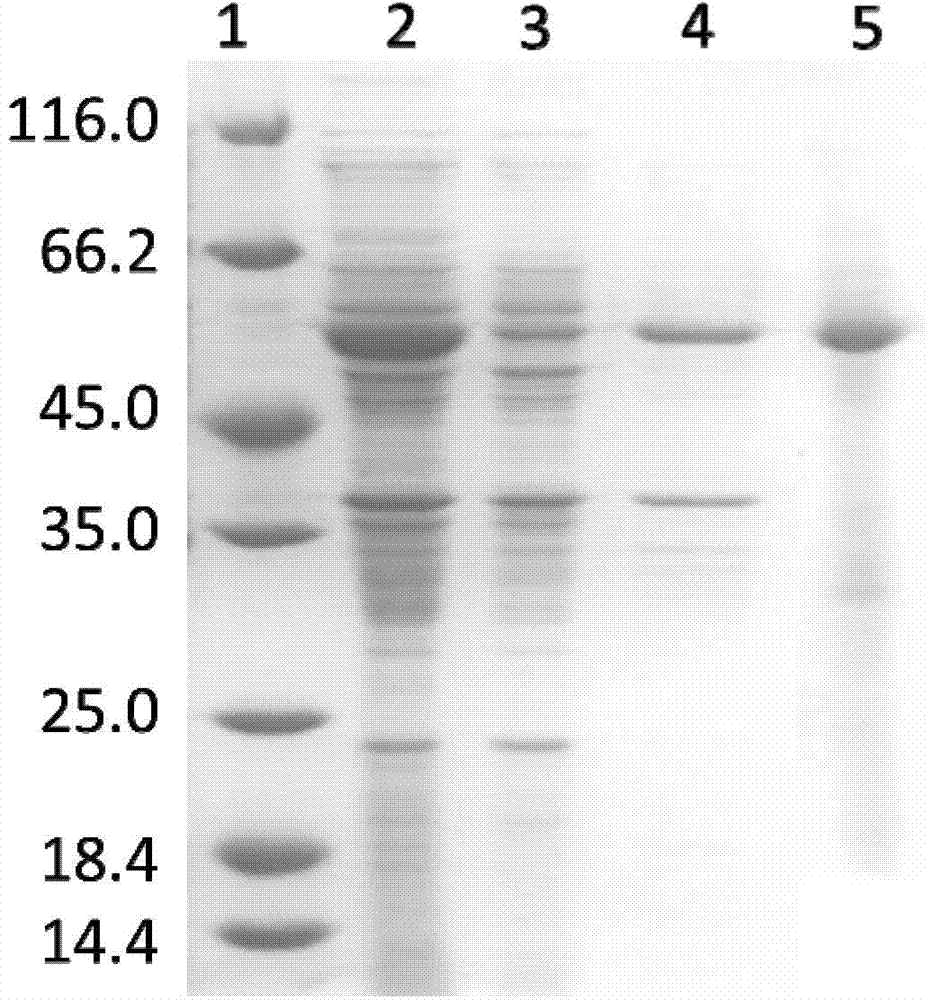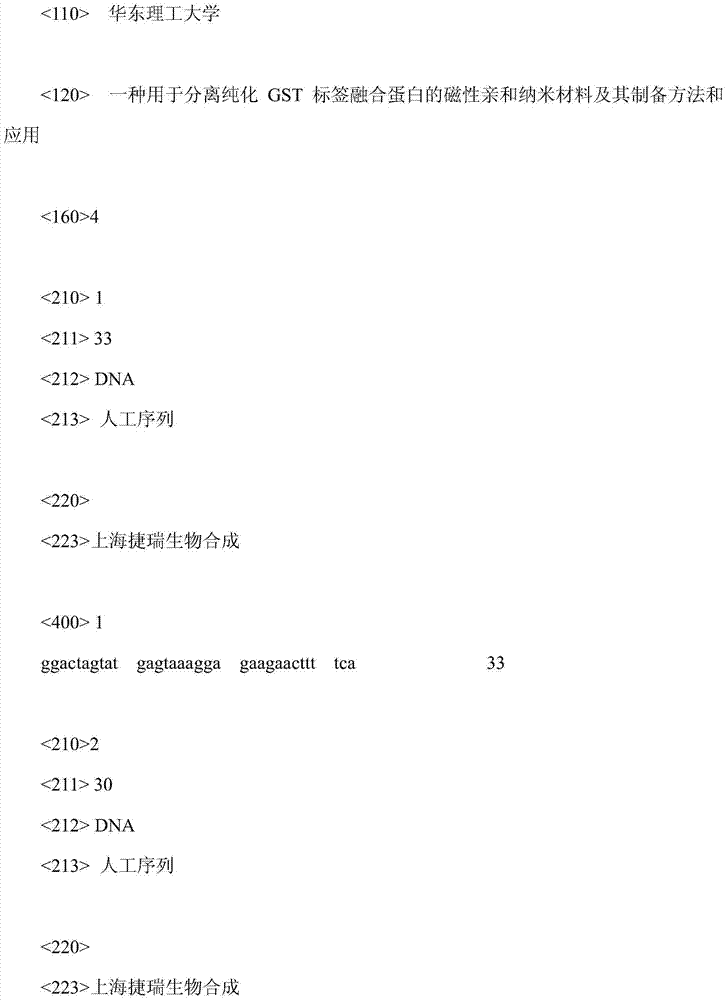Magnetic affinitive nanomaterial for separating and purifying GST (glutathione S-transferase) tag fusion protein as well as preparation method and application thereof
A technology of nanomaterials and label fusion, applied in chemical instruments and methods, ion exchange, other chemical processes, etc., can solve the problems of high cost, complex synthesis and modification process, lack of GST label fusion protein, etc., to increase the binding rate and binding amount, wide application prospect and practical value, and the effect of simple preparation method
- Summary
- Abstract
- Description
- Claims
- Application Information
AI Technical Summary
Problems solved by technology
Method used
Image
Examples
Embodiment 1
[0023] Embodiment 1 Preparation of Magnetic Affinity Nanomaterial
[0024] (1) Weigh 2.7g FeCl 3 ·6H 2 O and 0.99 g FeCl 2 4H 2 O was dissolved in 250ml ultrapure water under the protection of nitrogen, the pH was adjusted to about 9 by adding 5M NaOH, stirred at 40°C for 2 hours, and ferric oxide nanoparticles were obtained by magnetic separation. Then it was dissolved in ultrapure water to prepare a 1mg / ml magnetic Fe3O4 nanoparticle solution.
[0025] (2) Disperse 50 mg of iron ferric oxide nanoparticles in 50 mL of Tris-HCl buffer (10 mM, pH 8.5), ultrasonically disperse for 15 minutes, and add 50 mg of dopamine hydrochloride. After stirring at room temperature for 1 hour, polydopamine-modified Fe3O4 nanoparticles were obtained by magnetic separation.
[0026] (3) Disperse the above-mentioned polydopamine-modified iron ferric oxide nanoparticles in 50 mL of ultrapure water, add 100 mg of reduced glutathione, stir and react at room temperature for 6 hours, and separate...
Embodiment 2
[0028] Example 2 Separation and purification of GST-fused green fluorescent protein (GST-GFP)
[0029]The GST-GFP-producing recombinant Escherichia coli selected in this example was constructed in this laboratory by using the original green fluorescent protein gene as a template and fusing GST tags by means of genetic engineering (for the original green fluorescent protein gene without GST tags added, See Kaisa Hakkila, Mikael Maksimow, Matti Karp, Marko Virta, Reporter Genes lucFF, luxCDABE, gfp, and dsred Have Different Characteristics in Whole-Cell Bacterial Sensors, Analytical Biochemistry, Volume 301, Issue 2, Pages 235–242). Wherein, the plasmid containing the green fluorescent protein gene can be purchased through existing commercial channels, and the green fluorescent protein gene is amplified by PCR, and the forward primer used is: 5'-GGACTAGTATGAGTAAAGGAGAAGAACTTTTCA-3'; The primer is: 5'-CGGGATCCTTATTTGTATAGTTCATCCATG-3'. The PCR products were separated by agarose ...
Embodiment 3
[0031] The separation and purification of the lipase (GST-Lip) of embodiment 3GST fusion
[0032] The GST-Lip-producing recombinant Escherichia coli selected in this example was constructed in this laboratory by fusion of GST tags with lipase genes as templates (for the original lipase genes without GST tags, please refer to Bei Gao , Erzheng Su, Jinping Lin, Dongzhi Wei. Development of recombinant Escherichia coli whole-cell biocatalyst expressing a novel alkali lipase-coding gene from Proteus sp. for biodiesel production. Journal of Biotechnology. 2009,139(2):169-175) . Wherein, the plasmid with the lipase LipK107 gene can be purchased through existing commercial channels and used as a template to amplify the lipase LipK107 gene by PCR. The forward primer used is: 5'-GGACTAGTATGTCAACGAAATATCCTATC-3 '; the reverse primer is: 5'-GGAATTCTTAAAGTTGCTTACTCGCTAAG-3'. The target gene fragment was recovered by gel recovery, and the fragment was double-digested with SpeI and EcoRI r...
PUM
| Property | Measurement | Unit |
|---|---|---|
| The average particle size | aaaaa | aaaaa |
Abstract
Description
Claims
Application Information
 Login to View More
Login to View More - R&D
- Intellectual Property
- Life Sciences
- Materials
- Tech Scout
- Unparalleled Data Quality
- Higher Quality Content
- 60% Fewer Hallucinations
Browse by: Latest US Patents, China's latest patents, Technical Efficacy Thesaurus, Application Domain, Technology Topic, Popular Technical Reports.
© 2025 PatSnap. All rights reserved.Legal|Privacy policy|Modern Slavery Act Transparency Statement|Sitemap|About US| Contact US: help@patsnap.com



